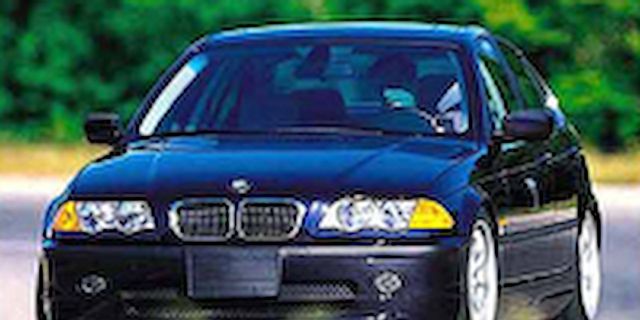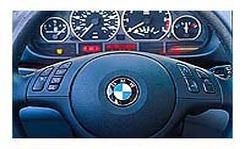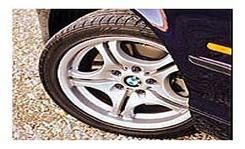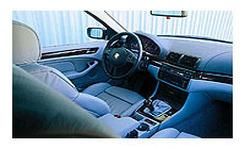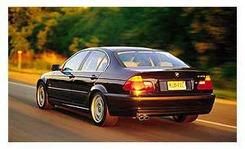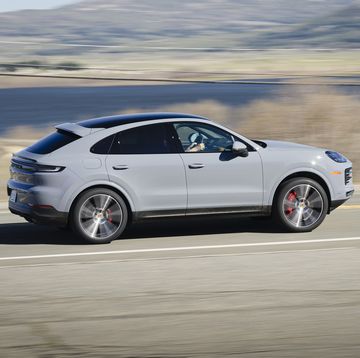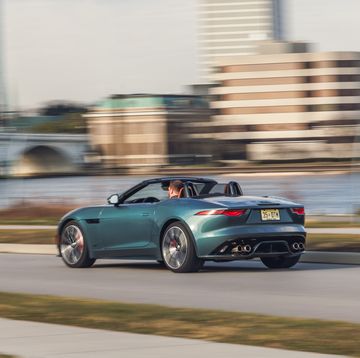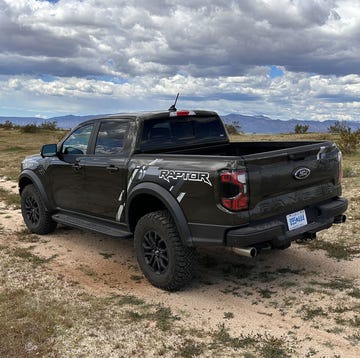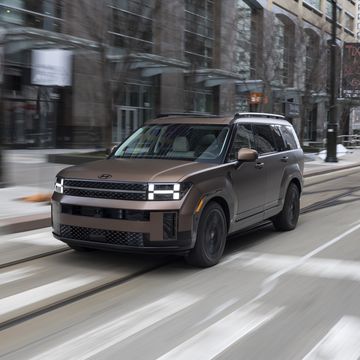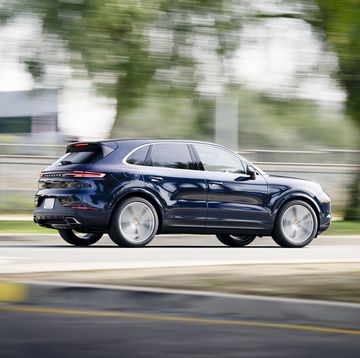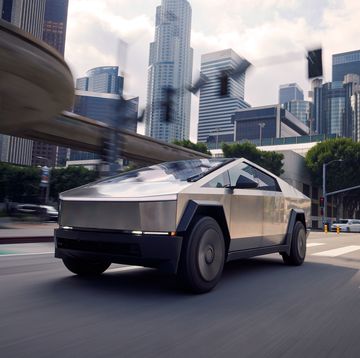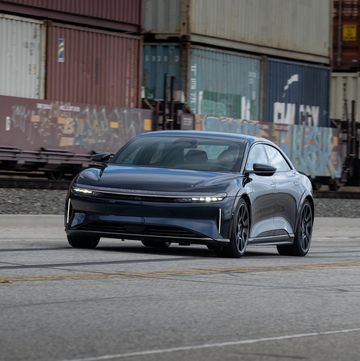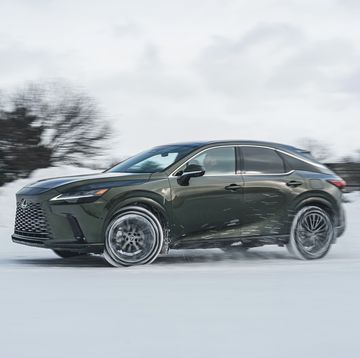From the December 2000 issue of Car and Driver.
We hold these truths to be self-evident: that all BMWs are more or less good cars, that they are endowed by their creator with certain indispensable abilities, among these are speed, agility, and the precision of neutral steering, and that when any form of change becomes destructive of these ends, it is the right of the people to dissolve the bonds which have connected them to BMW and to spend the cash on a used Zimmer.
Of course, such declarations are nothing short of treason to loyalists whose passage to Valhalla lies somewhere between the second and third gate of a ZF Type C gearbox bolted to any engine fitted with a blue and white roundel and six pots standing at attention. Fortunately for them and everyone else, the new 330i won't incite a revolution against the Old Order. It pretty much kicks fanny.
That's because the new engine grinds some real burr into the E46's otherwise velvety persona. It yanks the car out of apexes with a firmer tug and punts it to freeway speeds with all the attitude of a howitzer shell. With the holes open, the exhaust sings almost in tune with a Boxster at full boil. Okay, so it clipped mostly just fractions of seconds off the times of the last 328i we tested (November 1998), but our eyes, ears, and keisters say the car feels substantially rejuvenated.
This was by no means a foregone conclusion. The current E46 generation of the 3-series demonstrates that the company is not above tinkering with the core traits that made BMW a blue-chip brand among enthusiasts. The base E46's increased flab, its softer ride and steering, and the general inching of the car toward the side of cushiness are reprimands this publication has printed in the recent past.
With the 330i, BMW might have taken the opportunity afforded by greater power to nudge the car even more toward epicurean blandness. Last spring, for example, BMW announced in Munich that E46s built after June will have more steering boost to make parking easier. Judge for yourself the implications; we nearly choked on our Wiener schnitzel. What's next? An Autronic Eye on the dash to automatically dim the headlights?
The most obvious difference between the base 330i and 328i is the additional $590 that buys you six 496.5cc cylinders instead of six 465.5cc cylinders. The blip in displacement is courtesy of a stroke increase of 5.6 millimeters to 89.6mm. BMW says the added cubes only account for about 30 percent of the power spike over the 2.8-liter engine, which made 193 hp and 206 pound-feet, compared with the 330i's 225 hp and 214 pound-feet. Another 57 percent comes from fiddling with the profiles of the twin-chamber intake-manifold and exhaust ports, and the rest comes from changes in the cam profiles. Happiness through better breathing, in other words.
Thanks to the intake finagles shared with the 3.0-liter, the base 2.5-liter six also gets a 14-hp jolt to 184 hp. To be clear, every horse in the growing 3-series corral, including the wagons, coupes, sedans, convertibles, and their all-wheel-drive variants, will still offer the 2.5 (it will be the only choice in the wagon). And order returns to BMW's nomenclature, as a car with the 2.5 will be labeled properly as a 325, not a 323 as last year.
The M54, as the new engine is dubbed at Bimmer Central, employs basically the same architecture that debuted on BMW's original small six-banger in 1977, which didn't migrate to these shores till 1984. Since then, the engine has acquired a few tweaks, including twin cams, multivalve heads, an aluminum block, Nikasil-coated cylinder liners, and variable valve timing that BMW calls VANOS for "Variable Nockenwellen Spreizung." According to our Microsoft translator, that means "variable knockwurst splicer" and not "variable camshaft adjustment" as the press kit would have us believe.
On the M54, the double-VANOS's oil-pressurized pistons rotate both the intake and exhaust camshafts within a range of 40 degrees and 25 degrees, respectively. The benefits of this pricey widget accrue to tailpipe emissions, fuel economy, and torque.
That and the longer stroke equate to more torque where the 330i needs it. All 214 pound-feet arrive at 3500 rpm and remain at the party for more than a thousand revs. That pays off nicely at the track. Yes, the 330i only managed to beat the 328i by 0.3 second to both 60 mph and the 1320-foot mark. (It took 6.1 seconds to reach 60 mph and 14.8 seconds to run the quarter-mile at 95 mph vs. 6.4 seconds and 15.1 seconds at 93 mph for the 328i.) But look beyond these oft-quoted benchmarks for the real poop.
For example, in the 5-mph street start, where the engine has to start pulling from low revs, the 330i bested the old model by a full half-second. The drei-liter was nearly a second quicker in top-gear acceleration runs from 30 to 50 mph, another test of low- and midrange torque. It was a full second faster to 100 mph, taking just 16.6 seconds.
Before you start bleating about gear ratios, be aware that the six cogs that matter (including the one in the back) are identical to those found in a 328i. Keisters may deceive, but Datrons don't, and ours says the 330i offers more usable street-level power.
That makes the E46's status as King of the Teutons more secure than ever. The 330i's performance destroys that of the last A4 2.8 Quattro to grace these premises. In our "Bavarian Burners" comparo in November 1998, the Audi ran to 60 mph in 7.4 seconds and did the quarter in 15.8 seconds at 89 mph. Its braking and skidpad numbers were slightly poorer, too, although an Audi costs substantially less than the new BMW (a base 2001 A4 2.8 is about $3000 less than the 330i's base price).
For conversation's sake, also note that the 330i fairly slaughters the times of the new Mercedes-Benz C320 Sport (C/D, November 2000), which has 10 fewer horsepower but 15 more pound-feet of torque. Equipped with an automatic (the five-speed is only available in the C240, which we haven't tested yet), the Mercedes ran to 60 mph in a creampuff 7.5 seconds and consumed the quarter in 15.8 seconds at 91 mph. To 100 mph, the BMW is 3.5 seconds faster. Yowza!
To be fair, the transmissions should be identical, but Mercedes refuses to send a manual C320 to the U.S. And the gilded prose we expended on the new C-class in November is justified by the fact that its braking and handling are a huge step up from its predecessor's and nearly identical to those of the tested 330i, which was equipped with the optional $1200 Sport package.
By the way, for 2001 BMW has knocked 150 clams off the model-year 2000 price of the Sport package and thrown in the narrow-spoke alloy wheels and larger 245-section Z-rated rear tires that were only available on the two-door last year. Just tack on $1.50 for a new toothbrush to clean the brake smut out of the finger-squeezing slots in the wheels.
Lest you think BMW is all heart, consider that it packed an extra $950 into the price of the $3850 Premium package, which bags you essentially the same list of goodies (leather, sunroof, wood trim, power lumbar) as last year. If you want performance, you get a break; if you want luxury, you pay. What's the problem?
Counterpoint
Hmm, let's see, a BMW 3-series with more power. Yes, I like that just fine. Like everyone else on the planet, I too was a fan of the 2.8-liter version of the straight-six. It delivered torque in a nice, fluid way and made more than adequate power. Now, with the 3.0-liter, you simply get more. With the 2.8-liter, you'd consider downshifting for a pass and then decide to just dip into the throttle a bit deeper. Now, you don't even think about it. And the extra torque is delivered with a throatier exhaust note. The only disappointment is the steering, which, although as accurate as ever, has been lightened to satisfy parking-lot jockeys. Which is just wrong. —Daniel Pund
Whatever the vehicle, adding more thrust‚and in this case it's enough added thrust to be instantly noticeable—produces a couple of effects. One of them is pretty easy to discern: The car goes faster —particularly in traffic-dissection mode, which for most of us is most of the time. But the other, less-obvious effect is to remind us how well BMW does its homework in the spring-and-damping department. Although the 330i hurls you into corners quicker, its comfort and composure haven't diminished by a scintilla. Okay, the limp-wrist steering effort is a little startling. But aside from that, this is still the car the other guys wish they could build. —Tony Swan
Back in December 1987, the first BMW M5, with its 6900-rpm, race-derived 3.5-liter six, ripped from 0 to 60 mph in 6.3 seconds. Now, the new 330i betters that M5's time by 0.2 second without breathing hard. Effortless performance is the hallmark of the current 3-series, which couples an absorbent ride with excellent body control and razor-sharp responses. Light but accurate steering has been a key ingredient in this satisfying recipe. But in this new 330, the power assistance is light enough to dial with one finger. For a car that can run with that rorty old M5, such featherweight steering simply won't do. —Csaba Csere
